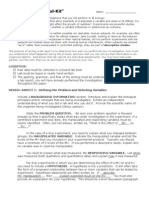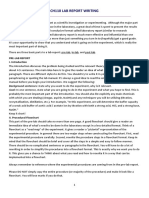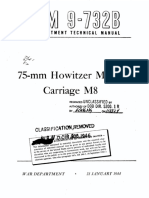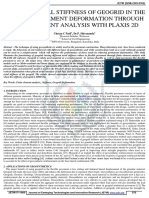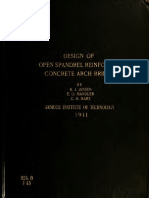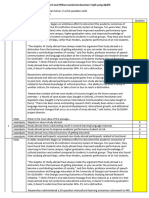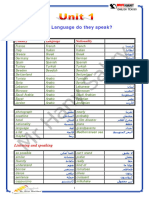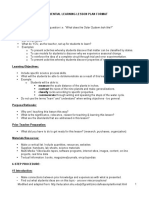E101 Summary of Report
E101 Summary of Report
Uploaded by
Anizza Marie SakilanCopyright:
Available Formats
E101 Summary of Report
E101 Summary of Report
Uploaded by
Anizza Marie SakilanOriginal Title
Copyright
Available Formats
Share this document
Did you find this document useful?
Is this content inappropriate?
Copyright:
Available Formats
E101 Summary of Report
E101 Summary of Report
Uploaded by
Anizza Marie SakilanCopyright:
Available Formats
E101: Resolution of Forces
Sakilan, Anizza Marie D.
PHY10L/A6
CE/2
1. INTRODUCTION
This experiment is all about the resolution of forces. The objectives of this experiment is to analyze the
components of force, determine the resultant and equilibrant and compare the results of the given methods.
2. METHODOLOGY
Three methods were used in this experiment. First is by trial and error. Four pulleys with mass hangers are
attached to a force table. Weights are then added into each mass hanger. The angle of the strings were
adjusted and the weights are varied. This will determine the equilibrant (F4). Another way is by graphical
method. Vectors are drawn using measuring tools to determine the resultant. Lastly, the value of the
resultant is computed using formulas in analytical method.
3. DATA AND RESULTS
After a few trials, the desired results were acquired. By using the force table, Basically, this is the easiest
part to write because it is a straightforward statement of exactly what you observed and found. This section
is not for interpreting the data in any way. You should only narrate your findings without trying to analyze
them, other than to provide a link to the discussion section. Perhaps the best way to use the results section
is to show the most relevant information you obtained. This section should also contain 50 to 80 words
only.
4. ANALYSIS
The analysis section is the most important part of your document. This should contain at least half of your
document, that is, 125 to 200 words. In this section, you start the process of explaining any links and
correlations apparent in your data. In an ideal world, you could simply reject your null or alternative
hypotheses according to the significance levels found by the statistics. That is the main point of this section,
but the process is usually a lot more complex than that. It is rarely clear-cut, and you will need to interpret
your findings. It is also important that you should criticize the experiment, and be honest about whether
your design was good enough. If not, suggest any modifications and improvements that could be made to
the design. Moreover, the analysis section is not always about what you found, but what you did not find,
and how you deal with that. Stating that the results are inconclusive is the easy way out, and you must
always try to pick out something of value. Once writing the analysis section is complete, you can move
onto the next stage, wrapping up the paper with a focused conclusion.
You might also like
- NFC 33-020-2013Document20 pagesNFC 33-020-2013Jonutz100% (4)
- SevenRooms VMS (Dining)Document20 pagesSevenRooms VMS (Dining)Charlotte's WangNo ratings yet
- ACT Math & Science Prep: Includes 500+ Practice QuestionsFrom EverandACT Math & Science Prep: Includes 500+ Practice QuestionsRating: 3 out of 5 stars3/5 (1)
- Practical Design of Experiments: DoE Made EasyFrom EverandPractical Design of Experiments: DoE Made EasyRating: 4.5 out of 5 stars4.5/5 (7)
- Writing A Science Lab ReportDocument11 pagesWriting A Science Lab Reportscientist farmasiNo ratings yet
- Writing A Science Lab ReportDocument10 pagesWriting A Science Lab ReportArief RhamdaniNo ratings yet
- Phy10 E101Document3 pagesPhy10 E101Risha SantiagoNo ratings yet
- How To Write A Lab ReportDocument5 pagesHow To Write A Lab Reportapi-298351628No ratings yet
- Lab Write UpDocument14 pagesLab Write UpRachel StandringNo ratings yet
- Lab ReportsDocument4 pagesLab Reportsaddisuyihune7No ratings yet
- Anatomy of A Lab ReportDocument3 pagesAnatomy of A Lab ReportAnonymous d8VDwVNo ratings yet
- Lab Format OutlineDocument4 pagesLab Format Outlinecharmdoodle6965No ratings yet
- Examples of Abstracts: An Example Abstracts From A Chemistry ReportDocument5 pagesExamples of Abstracts: An Example Abstracts From A Chemistry ReportNgu LynNo ratings yet
- How To Write A Lab Report To Impress Your TA PDFDocument5 pagesHow To Write A Lab Report To Impress Your TA PDFTonya NormanNo ratings yet
- Chemistry: Overview Guidelines Samples Lab ReportsDocument4 pagesChemistry: Overview Guidelines Samples Lab ReportsleunammeNo ratings yet
- First Years Physics Lab Manual - 2023-2024Document196 pagesFirst Years Physics Lab Manual - 2023-2024mwendwakelvin842No ratings yet
- Physics - Lab Reports & RubricsDocument4 pagesPhysics - Lab Reports & Rubricsapi-464156291No ratings yet
- Assignment Three - EP - MNDocument3 pagesAssignment Three - EP - MNmattkorir25No ratings yet
- How To Write A LabDocument2 pagesHow To Write A Labrusyamac19No ratings yet
- Rhs Science Lab Report GuidelinesDocument2 pagesRhs Science Lab Report Guidelinesapi-268599570No ratings yet
- Well-Written Lab ReportDocument4 pagesWell-Written Lab Reportasma.sharabNo ratings yet
- E101 Summary of ReportDocument1 pageE101 Summary of ReportAnizza Marie SakilanNo ratings yet
- Guidelines For Writing Lab ReportDocument2 pagesGuidelines For Writing Lab ReportMohammad OzairNo ratings yet
- ENGR221 Lab Report Guidelines Spring CW 2024Document7 pagesENGR221 Lab Report Guidelines Spring CW 2024fhhdghgjfggNo ratings yet
- Lab Reports GuideDocument10 pagesLab Reports Guidecrisanto ValdezNo ratings yet
- List of Mistakes and CommentsDocument12 pagesList of Mistakes and Commentsyaqoob MahNo ratings yet
- Practicals Part I ManualDocument37 pagesPracticals Part I Manualparlypalesa90No ratings yet
- Lab Report ChemistryDocument17 pagesLab Report ChemistryLeiunice BalbinNo ratings yet
- Panduan Membuat Lab ReportDocument7 pagesPanduan Membuat Lab ReportSaifullah SuhairiNo ratings yet
- Write Up Format For Project STEM PhysicsDocument6 pagesWrite Up Format For Project STEM PhysicsDY BelchezNo ratings yet
- Ib Lab Cheat Sheet 2Document7 pagesIb Lab Cheat Sheet 2Sartorialist100% (1)
- Cell and Molecular Biology LaboratoryDocument6 pagesCell and Molecular Biology LaboratoryasddassadNo ratings yet
- Physics 1 and Physic 2 SPH 2170 and 2171Document31 pagesPhysics 1 and Physic 2 SPH 2170 and 2171ayonga ochako erickNo ratings yet
- The Lab Report WordDocument12 pagesThe Lab Report Wordtatheer zahraNo ratings yet
- Writing A Laboratory ReportDocument5 pagesWriting A Laboratory ReportPhoenixNo ratings yet
- Science Lab Report FormatDocument7 pagesScience Lab Report FormatktyasirNo ratings yet
- How To Write A Lab ReportDocument8 pagesHow To Write A Lab ReportEthan ZhengNo ratings yet
- How To Write A Laboratory ReportDocument2 pagesHow To Write A Laboratory Reportandersonmack047No ratings yet
- Short Report FormatDocument3 pagesShort Report FormatBrandon LimNo ratings yet
- How To Write A Lab ReportDocument17 pagesHow To Write A Lab ReportDeimante BlikertaiteNo ratings yet
- Parts of A Lab ReportDocument2 pagesParts of A Lab Reportamritmaharaj543No ratings yet
- Telecom Networks Lab I Laboratory Report Writing Format: 1 Title PageDocument2 pagesTelecom Networks Lab I Laboratory Report Writing Format: 1 Title PageTemesgen AmbawNo ratings yet
- PHY212Document56 pagesPHY212Sujan ReddyNo ratings yet
- Formal Lab Report Guide HonorsDocument4 pagesFormal Lab Report Guide HonorsEileen LoughmanNo ratings yet
- Ch110 Lab Report WritingDocument5 pagesCh110 Lab Report WritingLazy BanditNo ratings yet
- Guideline To Laboratory Report Writing PDFDocument2 pagesGuideline To Laboratory Report Writing PDFIjal JaminNo ratings yet
- Laboratory Report ManualDocument6 pagesLaboratory Report ManualAmira BronNo ratings yet
- Laboratory Manual: Physics 1012/2112 Electricity and MagnetismDocument79 pagesLaboratory Manual: Physics 1012/2112 Electricity and MagnetismRehnuma Naher SumonaNo ratings yet
- Laboratory Report Format: What and Why How What You Found What It MeansDocument4 pagesLaboratory Report Format: What and Why How What You Found What It MeansSophia NuelleNo ratings yet
- Lab Report FormatDocument3 pagesLab Report FormatFregie Jun AcuramNo ratings yet
- CELLLS Part21Document2 pagesCELLLS Part2139627341No ratings yet
- IB Biology Lab "Tool-Kit": LogisticsDocument7 pagesIB Biology Lab "Tool-Kit": LogisticsSciencefun23No ratings yet
- Field ExperimentationDocument112 pagesField ExperimentationOsman RufaiNo ratings yet
- Scxzscxzsioclxzhucoxzhnsuvhihdijpzsicjnxkz Oiaidipa (PWDocument2 pagesScxzscxzsioclxzhucoxzhnsuvhihdijpzsicjnxkz Oiaidipa (PWsachmanpasrija19No ratings yet
- Evidence Based ActivityDocument3 pagesEvidence Based ActivityRegine CuntapayNo ratings yet
- PHY13L-Summary of Experiment TemplateDocument1 pagePHY13L-Summary of Experiment Templateanon_422073337No ratings yet
- How To Write A Lab Report For General Biology 102Document1 pageHow To Write A Lab Report For General Biology 102anonymousscribdNo ratings yet
- Lab Manual (PHYS 001)Document36 pagesLab Manual (PHYS 001)AavaNo ratings yet
- Research & the Analysis of Research Hypotheses: Volume 2From EverandResearch & the Analysis of Research Hypotheses: Volume 2No ratings yet
- Regents Exams and Answers Physics Physical Setting Revised EditionFrom EverandRegents Exams and Answers Physics Physical Setting Revised EditionNo ratings yet
- Laboratory Practice, Testing, and Reporting: Time-Honored Fundamentals for the SciencesFrom EverandLaboratory Practice, Testing, and Reporting: Time-Honored Fundamentals for the SciencesNo ratings yet
- AQA Psychology A Level – Research Methods: Practice QuestionsFrom EverandAQA Psychology A Level – Research Methods: Practice QuestionsNo ratings yet
- Gas BillDocument2 pagesGas Billiacovbns1No ratings yet
- 75-mm Howitzer Motor Carriage M8: War Department Technical ManualDocument321 pages75-mm Howitzer Motor Carriage M8: War Department Technical Manualitetsuzo100% (1)
- Text7 The Invisible ManDocument4 pagesText7 The Invisible ManОлександра ХаринаNo ratings yet
- QP SuryaDocument24 pagesQP SuryaYateendra TummalapalliNo ratings yet
- Fluid Mech C1.3Document2 pagesFluid Mech C1.3Kyle NeillyNo ratings yet
- 8 F 7 ADocument5 pages8 F 7 Aศิวาเวช อบมาNo ratings yet
- Burleigh 2Document3 pagesBurleigh 2Jim WestNo ratings yet
- SRS WANDERLUSTDocument21 pagesSRS WANDERLUSTk224827 Anum AkhtarNo ratings yet
- Design of Open Sprandel Reinforced Concrete Arch Bridge PDFDocument114 pagesDesign of Open Sprandel Reinforced Concrete Arch Bridge PDFGuntara Muria AdityawarmanNo ratings yet
- Tesol sp5 2016 Assessment 2Document24 pagesTesol sp5 2016 Assessment 2api-350584888No ratings yet
- Best Start Kindergarten Assessment: Literacy: A Parent's GuideDocument1 pageBest Start Kindergarten Assessment: Literacy: A Parent's Guidemich1984No ratings yet
- Brownian Motion & Diffusion: - DefinitionDocument9 pagesBrownian Motion & Diffusion: - DefinitionAndreaNo ratings yet
- Computer BasicsDocument409 pagesComputer Basicsmukesh_kumar_470% (1)
- Soal Bahsa Inggris Try Out 9Document15 pagesSoal Bahsa Inggris Try Out 9Rico indra HNo ratings yet
- Downstream Process For CrystallizationDocument7 pagesDownstream Process For CrystallizationSaravanakumar BagavthyNo ratings yet
- Introduction of JAVADocument12 pagesIntroduction of JAVARahul SinghNo ratings yet
- Basic Principles of Trauma ManagementDocument53 pagesBasic Principles of Trauma ManagementMohamed Saeed Bachoo100% (1)
- Written TestDocument4 pagesWritten TestFERDINAND BANAGANo ratings yet
- Towing Design Rev2Document19 pagesTowing Design Rev2Ludovic LandemaineNo ratings yet
- Quijano-Solis Carlos J 201511 PHD ThesisDocument198 pagesQuijano-Solis Carlos J 201511 PHD ThesisshanthakumargcNo ratings yet
- Typical Deck DetailsDocument20 pagesTypical Deck Detailskohatian27796105100% (1)
- Structural Integrity Test (Schmidt Hammer) - FadeyiDocument16 pagesStructural Integrity Test (Schmidt Hammer) - FadeyiBukayoNo ratings yet
- Desa Laguna Brochure 2023 v2-5Document40 pagesDesa Laguna Brochure 2023 v2-5freddysh4330No ratings yet
- Grade 5 Order of Adjectives BDocument2 pagesGrade 5 Order of Adjectives BJeffNo ratings yet
- InsectID Guide PDFDocument42 pagesInsectID Guide PDFAngela Cristina AmuzaNo ratings yet
- Move Ahead 1 1-6Document45 pagesMove Ahead 1 1-6Laila EssamNo ratings yet
- Des Lessonplan PDFDocument3 pagesDes Lessonplan PDFbabunaidu2006No ratings yet
- Network For Small OfficeDocument7 pagesNetwork For Small OfficeIndranil DasNo ratings yet






























